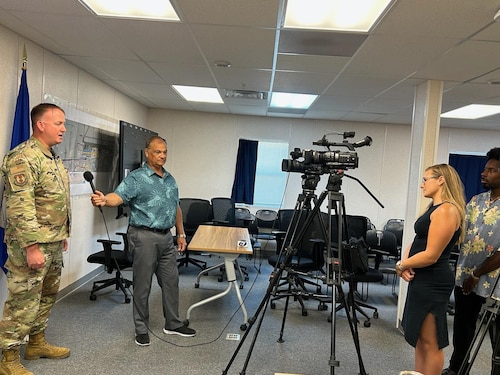In the wake of Category 4 Typhoon Mawar, a team of Air Force Installation and Mission Support Center disaster recovery experts departed for Andersen Air Force Base, Guam, May 26 to assist with storm damage recovery at the vital Pacific installation.
The five-person Disaster Recovery Response Team from the Air Force Civil Engineer Center's Natural Disaster Recovery Division left this Tyndall AFB, Florida, early May 26. Their arrival to the island was expected to take a day or two, based on military flight availability and the reopening of the Andersen runway.
Typhoon Mawar struck Guam May 24, bringing powerful winds and torrential rain to the island. Early in the aftermath, information about the damage DRRT Team Leader Waylon Patterson and his team will face remains unclear.
"We understand there is some infrastructure and utility damage but won't know to what extent until we're actually boots on the ground, can see for ourselves and can do a full assessment," Patterson said.
The NDR was established in 2021 to enhance the Department of the Air Force's ability to recover from natural disasters. Led by AFCEC's Facilities Engineering Directorate, the Tyndall-based NDR Division provides strategic construction management to assist Air Force installations in quickly recovering from disasters and making infrastructure more resilient.
"Coming out of the initial recovery efforts of Hurricane Michael at Tyndall AFB and the flooding of Offutt AFB in Nebraska, AFIMSC quickly decided that we needed a standing capability, ready to respond to whatever the next natural disaster might be," said Col. Robert Bartlow, NDR division director. "From that, we stood up the disaster response cell within the NDR division."
Since then, the DRRT has responded to two natural disasters within the continental U.S.
With expertise, lessons learned and institutional knowledge, the DRRT guides Department of the Air Force installation leaders through the process of recovering from a natural disaster.
Tracking Typhoon Mawar from its geospatial cell at Tyndall AFB several days before it moved over Guam, Patterson waited for a signal from Andersen's 36th Wing leadership that help was needed.
The call came May 25.
"Many times, if you send people too early, you just add to an installation commander's problem set," Bartlow said. "Our team is going in very early, at the specific request of Andersen AFB, because they have unique expertise in both costs estimating and civil engineering."
"With natural disasters, the last thing you want is people rushing into an area with no power, water, etc.," Patterson said. "The commander and his teams have pressing issues as they are getting out and doing emergency clearing and restoration of utilities. They have to worry about the folks on their installation … things like how much water is available to them, do they have enough meals ready to eat if the dining facility is closed."
Unlike the previous responses to MacDill AFB, Florida, after Hurricane Ian and Little Rock AFB, Arkansas, in the wake of an ice storm, this tasking is very different. It's the team's first response outside of the continental United States and, because of its location, means they won't have their normal support equipment of a tractor 14-foot trailer with space for office equipment, tents, generators, air compressors and a host of other equipment.
Patterson likened it to going old school with a backpack crammed with personal protective equipment, tape measures, clipboards and paperwork. The only technology they'll have with them is a laptop, satellite phone and knowledge in their heads.
Once on the ground, Patterson and his team see themselves as an extension of the installation commander's support team, taking on several high-level responsibilities in the recovery process.
"Our first pressing issue is to come up with a dollar figure for how much it's going to cost to enact repairs," Patterson said. "The Department of Defense budgets for normal, routine needs, but when it comes to acts of God, we have to ask for supplemental funding … you can't pre-budget for storms."
Once they submit the initial cost estimate, the team moves on to the next phase: putting more fidelity to those numbers with individual projects.
"Each has to be submitted on separate documents, so we'll start filling those out once we know more," Patterson said.
Although the DRRT's time on the island is not yet known, they're targeting 30 days to accomplish their work.
"Mission success for AFIMSC and the NDR division will be "when the installation is able to fully categorize and quantify the damage it sustained with projects planned and programmed, to include accurate cost estimates for the recovery. That's our team's priority and their mission," Bartlow said.
"When we have an installation that sustains some sort of event that damages its infrastructure, that clearly affects our ability to project air power," the colonel said. "We need bases to project aircraft, so the quicker we can recover it and get it back to a state of full readiness, the quicker it can get back to projecting air power anywhere in the world."







